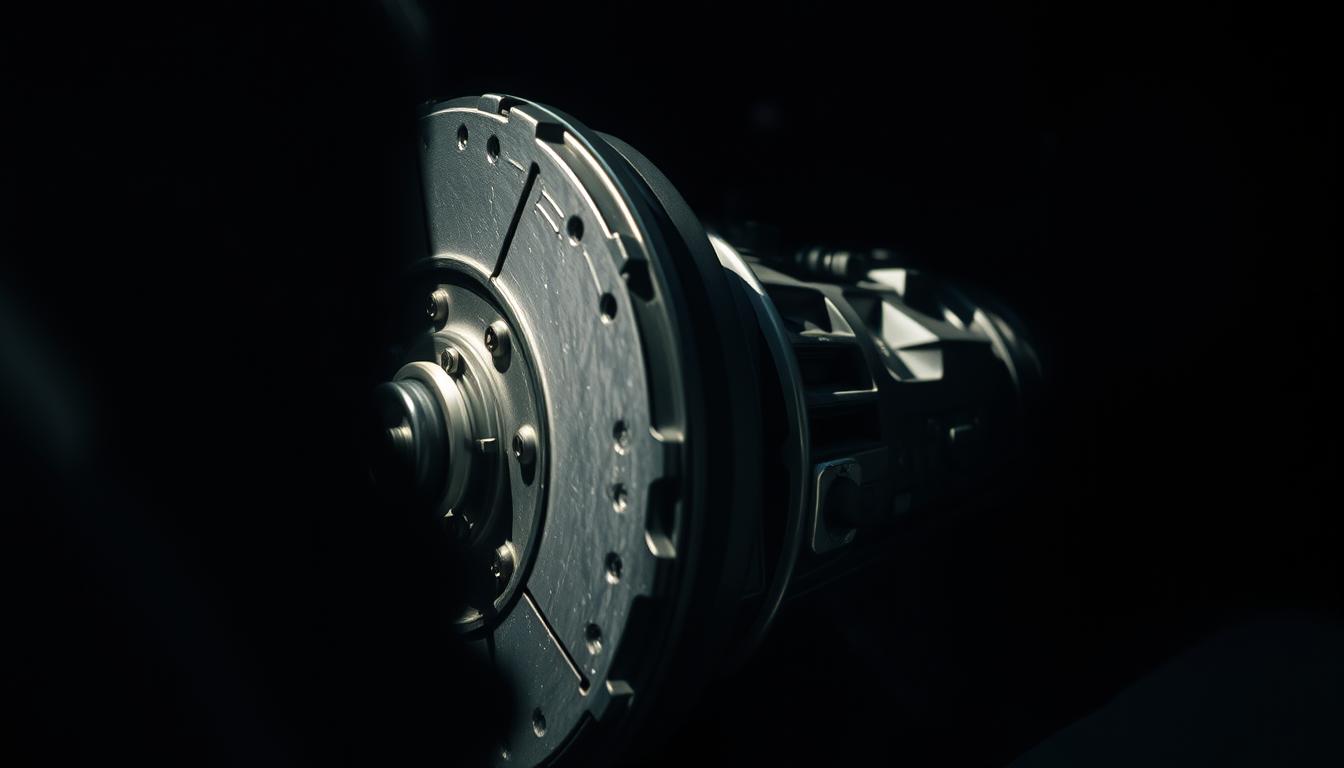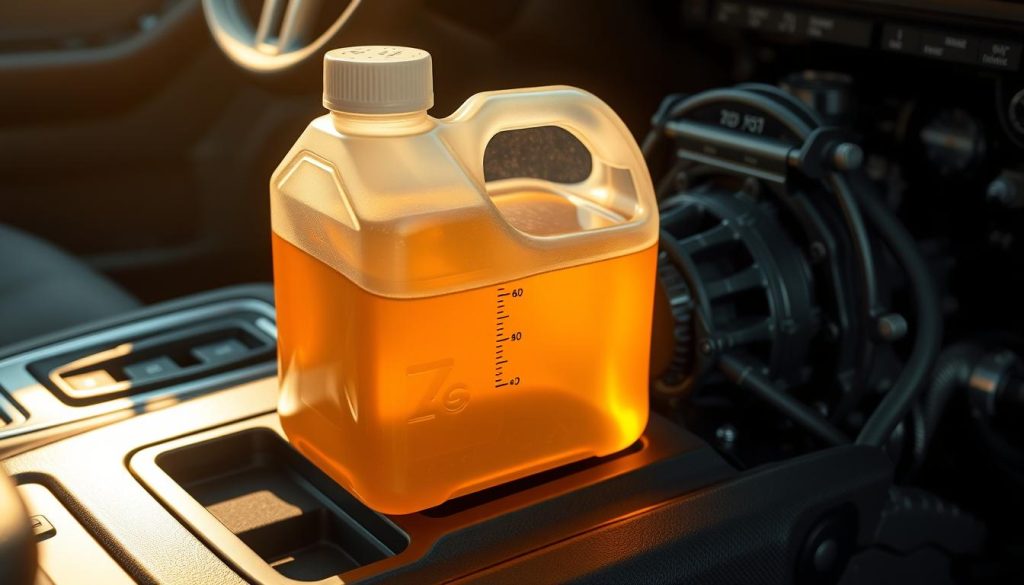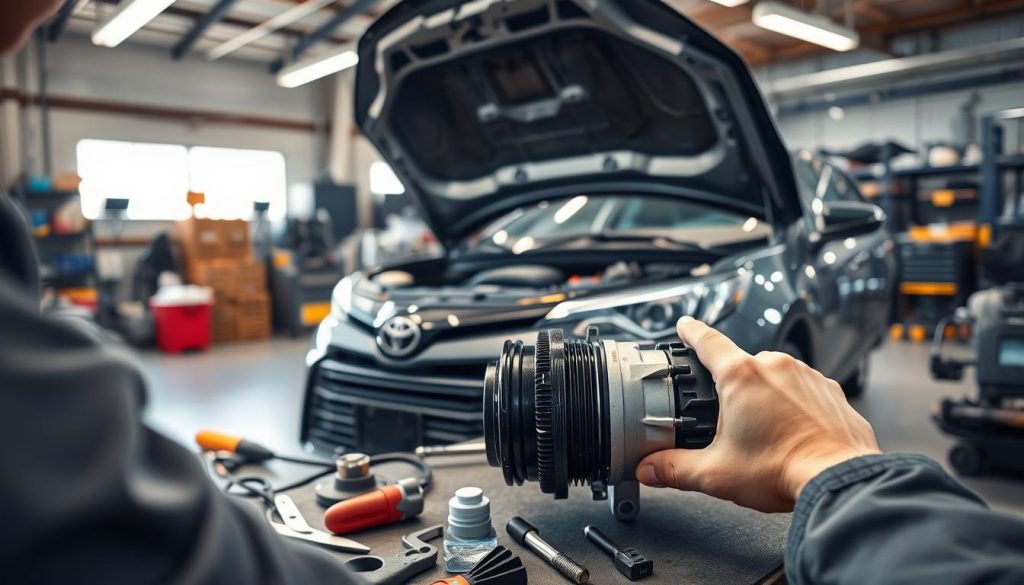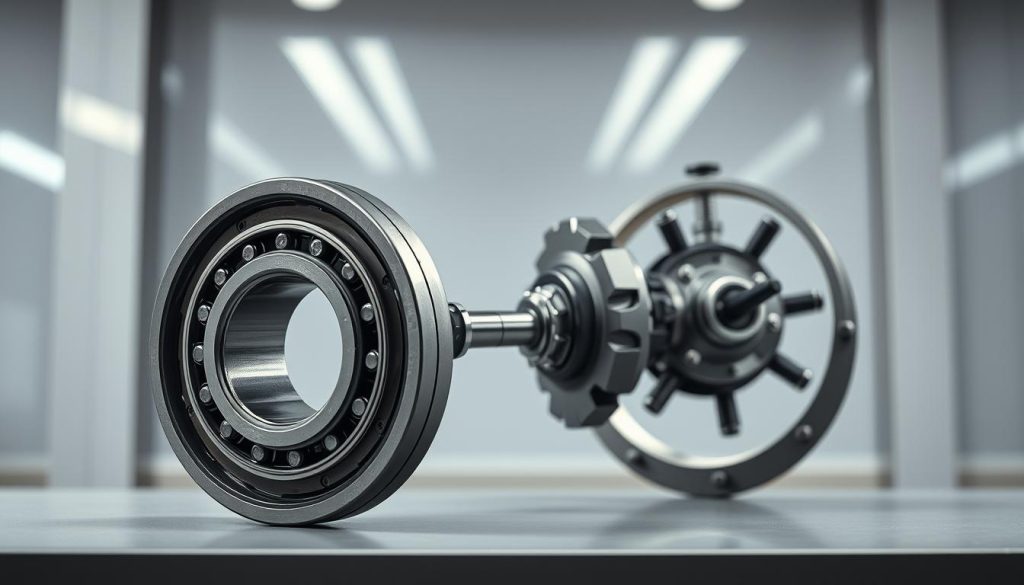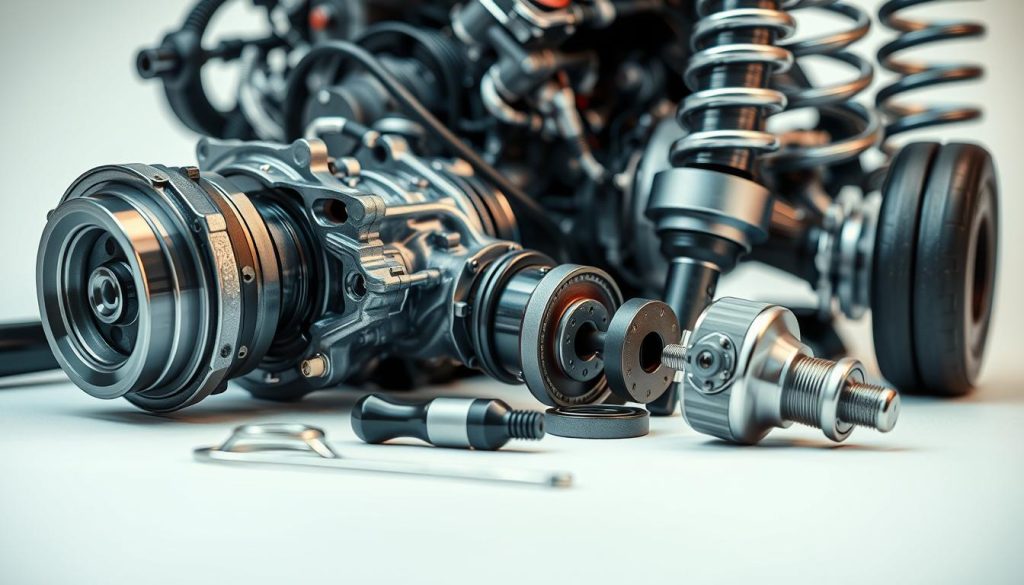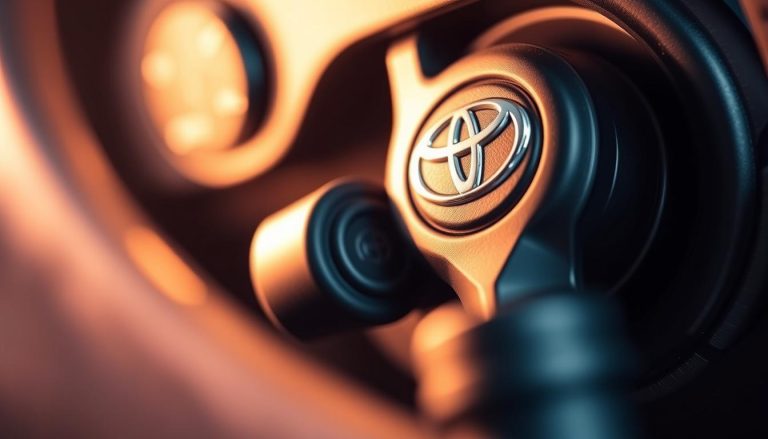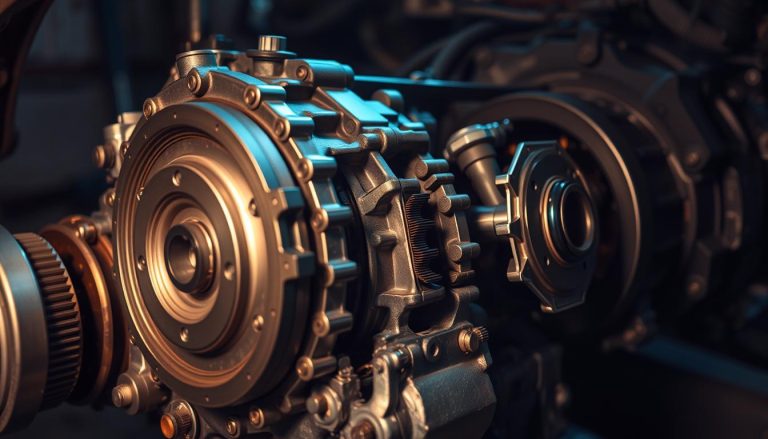Toyota Transmission Whining: Causes & Fixes
If you hear a whining noise in your Toyota, it’s important to find and fix the problem fast. This guide will help you understand why this happens, how to figure out what’s wrong, and how to keep your transmission in top shape. By tackling these issues, you can make sure your car drives well and stays safe.
Introduction to Toyota Transmission Whining
Whining noises from your Toyota’s transmission can be scary and confusing. Many Toyota owners face this problem and want to know why it happens. This guide will help you understand the causes and how Toyota maintenance can fix it.
Transmission whining usually means there’s a mechanical problem that needs fixing fast. Spotting these signs early can help your car last longer and run smoothly. The reasons for these noises can be low fluid levels, worn-out gears, or power steering pump issues. Each problem needs a specific fix.
Regular Toyota maintenance, like checking fluids and belts, can stop these noises before they start. We’ll explore the common causes and fixes for transmission whining. You’ll learn how to diagnose the problem and why using quality parts is key.
Common Causes of Toyota Transmission Whining
When your Toyota starts whining, it might mean several things are wrong. Finding out what’s causing the noise is key to keeping your car running right. Here are four main reasons for the whining: power steering pump issues, transmission problems, alternator issues, and serpentine belt problems.
Power Steering Pump Issues
A whining noise can signal power steering pump failure in Toyotas. This happens when the fluid levels are low or the pump isn’t working right. The sound gets louder when you steer, telling you to check the power steering system.
Transmission Problems
Transmission issues are another common cause of whining. Low fluid levels or problems in the transmission can cause these sounds. It’s important to check and keep the transmission fluid at the right level to prevent bigger problems.
Alternator Issues
Alternator failure can also make your Toyota whine. The alternator powers your car’s systems, and if it fails, you’ll hear a whine. Watching how the alternator works and fixing any problems early can keep your car running well.
Serpentine Belt Problems
A worn-out serpentine belt can also cause a whining noise. This belt runs your engine’s accessories, and it can wear out, crack, or break. Regular checks and replacing the belt when needed can stop this problem.
Diagnosing a Whining Noise in Your Toyota
Fixing a whining noise in your Toyota might seem hard. But, with the right steps, you can find the problem easily. Follow this guide to learn what might be causing the noise in your car.
Identify the Source
First, find out where the noise is coming from. Open your Toyota’s hood and listen carefully. This step is key because it helps you know exactly where to look, saving you time.
Check Fluid Levels
Then, check the fluid levels in your car. Low levels in the transmission or power steering can cause whining. Make sure all fluids are at the right levels, as your Toyota’s manual will tell you.
Inspect Belts and Hoses
Next, check all belts and hoses for damage. Look for cracks, fraying, or glazing. These can make strange noises. Replacing any worn-out parts might fix the problem.
Test the Vehicle
Now, test your Toyota under different conditions. Drive it at various speeds and listen for changes in the noise. This helps you see if the noise happens only when you’re speeding up or idling.
Use Diagnostic Tools
Lastly, use advanced tools for a detailed check. These tools give you insights that manual checks might miss. Using these diagnostic tips for car noise helps you find the problem thoroughly.
By following these steps carefully, you’ll not only save time but also keep your Toyota running smoothly. This will make your drives more enjoyable.
Transmission Fluid Levels and Their Importance
Keeping the right amount of transmission fluid is key for your Toyota’s health and performance. It keeps the transmission parts lubricated, cool, and prevents overheating. Low fluid levels can cause friction and a whining noise, which may damage the transmission.
- Lubrication: Right fluid levels reduce friction, making parts last longer.
- Cooling: Fluid helps cool the transmission, keeping it at the best temperature.
- Hydraulics: Fluid pressure is vital for the hydraulic system to work well, affecting gear shifts.
- Contaminant Clearing: Fresh fluid removes debris that could harm the internal parts.
Now, let’s look at what makes good transmission fluid:
| Characteristic | Ideal Level |
|---|---|
| Fluid Color | Cherry Red |
| Fluid Odor | Neutral |
| Fluid Level | Between Min and Max marks on dipstick |
| Presence of Particles | None |
Checking and topping up your transmission fluid regularly can prevent many problems. Sometimes, it’s best to flush and replace the old fluid for the best performance. This keeps your Toyota’s transmission running smoothly and quietly, avoiding expensive repairs later.
How to Fix Power Steering Pump Issues
Fixing your Toyota’s power steering pump needs careful steps for smooth operation. Keeping it well-maintained boosts your car’s performance and safety.
Checking Fluid Levels
Start by checking fluid levels. Low levels can lead to system noise and inefficiency. Here’s how to do it:
- Find the power steering fluid reservoir under the hood.
- Take off the cap and use the dipstick to check the level.
- If it’s low, add the recommended Toyota fluid type.
Regular checking fluid levels keeps your power steering system well-lubricated and working right.
Replacing the Pump
If topping off the fluid doesn’t fix the problem, you might need to repair or replace the power steering pump. Here’s how to replace it:
- Make sure your car is parked on a flat surface and the engine is off.
- Disconnect the battery for safety.
- Remove the belt connected to the pump.
- Unbolt and detach the old pump from its mount.
- Install the new pump by bolting it in place and reconnecting the belt.
- Reconnect the battery and fill the new pump with power steering fluid.
After these steps, start the engine and turn the steering wheel to full lock in both directions. This bleeds air from the system. Regular checks and, if needed, repairing the power steering pump, ensure a smooth drive.
Troubleshooting Toyota Transmission Problems
Dealing with Toyota transmission issues can be tough. But knowing the common problems and their signs can help you fix them. The main issues are low transmission fluid, worn-out gears, and failing transmissions.
Low Transmission Fluid
Low transmission fluid is a big problem. It can cause overheating and poor lubrication, leading to serious damage. Checking and keeping the fluid at the right level is key. Using the right fluid, as Toyota suggests, helps your car run better and last longer.
Worn-Out Gears
As your transmission gets older, gears can wear out. This can cause grinding noises, hard shifting, and poor performance. Fixing worn-out gears quickly can stop bigger problems. Regular checks and repairs can keep your gears in top shape.
Failing Transmission
Transmission failure is the worst problem. It can happen from low fluid, ignored maintenance, or serious damage. If you see slipping gears, slow shifting, or odd noises, get help fast.
Being careful and fixing these issues quickly keeps your Toyota running well. This way, you avoid expensive and serious problems later.
Identifying and Fixing Alternator Issues in Toyotas
Keeping your Toyota’s electrical system in top shape is vital. Spotting alternator failure signs is a big part of that. This guide will help you recognize these signs and decide if you need to repair or replace the alternator.
Signs of Alternator Issues
Alternator problems can show up in different ways. Here are some common signs to look out for:
- Dim or flickering headlights
- Electrical issues, such as malfunctioning power windows or seats
- Unusual noises, like grinding or whining
- Dashboard warning light indicating a battery or alternator problem
Repair or Replace the Alternator
When you spot alternator failure signs, choosing between repair or replacement is key. Consider these factors:
- Cost of repair vs. replacement
- Age and condition of the alternator
- Warranty on parts and labor
Here’s a comparison to help you make up your mind:
| Criteria | Repair | Replace |
|---|---|---|
| Cost | Generally lower, can be economical for minor issues | Higher, but often worth it if the alternator is old |
| Longevity | May prolong life but not as reliable as new | Provides a longer-term solution with a new component |
| Downtime | Quicker turnaround | May take longer due to installation and calibration |
Addressing Serpentine Belt Problems
The serpentine belt is key for your Toyota’s engine. It powers the alternator, power steering pump, and air conditioning compressor. Keeping it in good shape is vital for your car’s performance and life.
Signs of Wear and Tear
Spotting belt wear signs early can avoid bigger car troubles. Here are signs your serpentine belt might need fixing:
- Cracks and fraying along the edges
- Squealing noises from the engine bay
- Glazing or shiny spots on the belt
- Slack or visible damage
Regular checks can catch these belt wear signs early. Just looking at the belt for wear is a good start.
Proper Replacement Methods
For serpentine belt replacement, do it right to keep your engine running well. Here’s how:
- Check your car’s manual for belt replacement steps and routing.
- Loosen the tensioner pulley to take off the belt’s tension.
- Take off the old belt, noting its path for correct installation.
- Look over all pulleys and parts for damage or wear.
- Put the new belt on, following your manual’s diagram.
- Tighten the tensioner pulley to keep the belt in place.
- Start the engine and make sure the belt moves smoothly without noise.
Using the right tools and following these steps can make your engine last longer. It also helps avoid sudden breakdowns.
| Common Belt Wear Signs | Recommendations |
|---|---|
| Cracks and fraying | Replace the belt right away |
| Squealing noises | Check the belt’s tension and alignment |
| Glazing or shiny spots | Look for misalignment or slipping |
| Slack or visible damage | Tighten or replace the belt. |
Regular care and catching belt wear signs early can save you money. Fixing serpentine belt replacement issues quickly is a smart move for your Toyota’s health.
Understanding and Fixing Differential Issues
Vehicle maintenance means keeping an eye on your differential unit. Problems often show up as whining noises from the rear of your Toyota. This part talks about why differential maintenance is key and how to fix issues.
Low Differential Fluid
It’s important to check and refill differential fluid regularly. Low fluid can cause overheating and wear on gears. Here’s how to keep fluid levels right:
- Regularly check fluid levels using the dipstick or filler plug.
- Top up with the manufacturer-recommended differential fluid as needed.
- Inspect for leaks that might cause fluid loss.
Worn-Out Gears in the Differential
Gears in the differential can wear out over time. This causes grinding or whining noises. To fix worn-out gears, do the following:
- Perform regular inspections for unusual noises or vibrations.
- Replace damaged or worn gears promptly.
- Make sure to lubricate properly to reduce wear and tear.
Keeping your differential well-maintained is key for a quiet and smooth ride. By checking fluid levels and addressing gear wear, you can make your Toyota’s differential last longer and perform better.
Air Conditioning System Noises and Fixes
Unusual noises from your air conditioner can be unsettling. A noisy AC often means something’s amiss. Fixing these problems quickly can stop more damage and keep you comfortable.
Worn-out Components
Worn parts often cause air conditioner noise. The compressor, condenser, or fan belts can wear out, leading to strange sounds. These parts are key to your AC’s performance, so a single problem can affect everything.
- Compressor: The compressor is vital, and wear can cause loud noises.
- Condenser Fans: Faulty fan blades can make clicking sounds, hurting your cooling.
- Belts and Pulleys: Cracked or frayed belts can squeal.
Professional Diagnosis and Repair
If your AC is noisy, get expert help. Trained technicians can find and fix the problem accurately.
- Thorough Inspection: They check everything to find the noise’s source.
- Expert Repairs: They replace parts quickly, making your AC quiet and efficient.
- Preventive Maintenance: Regular checks can catch problems early, saving money.
A working air conditioner makes driving more comfortable. Fixing a noisy AC with professional help fixes the problem and keeps your AC running well for longer.
Checking for and Addressing Vacuum Leaks
Vacuum leaks can really hurt your car’s performance. They can cause the engine to run poorly, make strange noises, and use more fuel. It’s important to find and fix vacuum leaks quickly to keep your Toyota running well.
Signs of Vacuum Leaks
Finding vacuum leaks early can save you money and time. Look out for these signs:
- Rough idle
- Hissing noise from the engine
- Engine performance issues
- Poor fuel economy
- Illuminated check engine light
Methods to Detect and Fix Leaks
There are several ways to find and fix vacuum leaks:
- Visual Inspection: Start by looking at hoses and connections for cracks or loose connections.
- Soapy Water Test: Spray soapy water on possible leak spots. Bubbles mean you have a leak.
- Smoke Test: Use a smoke machine to find leaks. Smoke will show where air is escaping.
- Vacuum Gauge: A vacuum gauge can spot leaks by showing off-balance pressure readings.
- Repair and Replacement: Fix or replace the damaged part to keep the system working right.
By using these methods, you can find and fix vacuum system problems. This will make sure your Toyota runs smoothly and efficiently.
Wheel Bearings and Associated Noises
Wheel bearings are key for a smooth ride. Keeping them in good shape is vital. Knowing the signs of bad wheel bearings can save you from big repair bills.
Indicators of Worn-out Wheel Bearings
Spotting worn-out wheel bearings means looking for certain sounds and changes in how your car acts. Here are the main signs:
- Grinding Noise: A constant grinding sound when you’re driving, more noticeable when turning.
- Vibration: Feeling more vibration or wobble at the steering wheel.
- Uneven Tire Wear: Tires wearing down unevenly because the wheel isn’t aligned right.
- ABS Failure: The anti-lock braking system (ABS) warning lights coming on because of bad wheel bearing sensors.
Consequences of Ignoring Wheel Bearing Issues
Ignoring wheel bearing problems can lead to big problems. If you don’t fix them, you might face:
- Increased Repair Costs: Putting off repairs can make the damage worse, costing more to fix.
- Safety Risks: A bad wheel bearing can cause the wheel to come loose, which is very dangerous.
- Reduced Vehicle Performance: Bad wheel bearings can make your car handle poorly and perform worse.
Steps for Regular Toyota Maintenance
Keeping your Toyota in top shape means following a detailed maintenance plan. This plan includes regular checks and inspections. These steps help avoid costly repairs and make driving better.
Routine Fluid Checks
It’s important to check and top off key fluids regularly. This includes engine oil, brake fluid, transmission fluid, and coolant. Doing this on time helps prevent damage and keeps your engine running smoothly.
Regular Belt and Hose Inspections
Belts and hoses are key to your Toyota’s engine. Regular checks can spot wear and tear like cracks or leaks. Replacing them as needed keeps your car running reliably.
Following the Vehicle’s Service Schedule
Sticking to the Toyota service schedule is essential. It covers important services like spark plug changes, brake checks, and tire rotations. Following this schedule ensures your car gets the care it needs.
Importance of Using Quality Parts for Your Toyota
Keeping your Toyota running well means using top-notch parts. Choosing OEM parts ensures they fit perfectly and meet Toyota’s high standards. This boosts your car’s performance and extends its life.
When it’s time for repairs, picking the right parts is key. Cheap, non-OEM parts might save money upfront but can harm your car in the long run. Going with OEM parts protects your vehicle from damage and keeps it running smoothly.
| Aspect | OEM Parts | Aftermarket Parts |
|---|---|---|
| Quality | High consistency with original specifications | Variable, often lower |
| Warranty | Typically comes with manufacturer warranty | Limited or no warranty |
| Fit | Exact fit guaranteed | May require adjustments |
| Longevity | Designed for long-term use with specific models | Highly variable, generally shorter lifespan |
In short, choosing OEM parts for your Toyota is a smart move. It keeps your car in top shape and ensures it lasts longer. Opt for quality parts and enjoy the confidence that your vehicle is in its best condition.
Expert Diagnostic Tips for Toyota Transmission Whining
Finding out why a Toyota transmission whines can be tricky. Using professional car diagnostics and talking to skilled mechanics helps a lot. It makes finding and fixing the problem easier.
Using Advanced Diagnostic Tools
Adding advanced diagnostic tools to your car care routine helps a lot. These tools connect to your car’s computer. They give you real-time data to quickly find and fix problems.
- The OBD-II Scanner: This device reads diagnostic trouble codes (DTCs) from your vehicle’s computer system, providing insight into possible transmission-related problems.
- Oscilloscope: Useful for analyzing the electrical signals within the transmission system, helping to detect anomalies that might be causing the whining noise.
- Electronic Stethoscope: This tool allows for the precise location of the noise source, distinguishing it from other possible issues in the vehicle.
Consulting Professional Mechanics
While tools give great insights, talking to professional mechanics is key. They use their knowledge to understand the data and find the best fixes.
When you talk to a pro, they can:
- Check if the data is correct and rule out false positives.
- Look closely at the transmission parts for wear, damage, or misalignment.
- Give you the best fixes based on what they see and the data.
| Diagnostic Tool | Functionality | Benefits |
|---|---|---|
| OBD-II Scanner | Reads diagnostic trouble codes | Quickly finds specific problems |
| Oscilloscope | Analyzes electrical signals | Finds and fixes anomalies |
| Electronic Stethoscope | Locates noise sources | Finds and fixes exact problem areas |
Conclusion
Understanding why your Toyota transmission whines is key for car owners. We’ve looked at many problems, like power steering pump issues and worn-out wheel bearings. We’ve given you detailed advice on how to fix these problems.
Acting fast is important to avoid more damage. Regular checks, keeping fluids right, and knowing your transmission are vital. They help prevent expensive repairs later.
Fixing transmission whining quickly makes your car safer and more reliable. By following these maintenance tips, you’ll make your Toyota last longer. You’ll also enjoy a quieter ride. This advice is meant to help you tackle any transmission issues with confidence.
FAQ
What are the common causes of transmission whining in Toyota vehicles?
Transmission whining in Toyotas can be caused by several things. Issues with the power steering pump, the transmission itself, the alternator, and the serpentine belt are common culprits.
How can I diagnose the source of a whining noise in my Toyota?
To find the source of a whining noise, start by identifying where the noise is coming from. Then, check the fluid levels. Look at belts and hoses for damage. Test the vehicle under different conditions. Use advanced tools for a detailed diagnosis.
Why is it important to maintain transmission fluid levels in my Toyota?
Keeping the transmission fluid at the right level is key. It keeps your Toyota’s transmission healthy and running smoothly. This prevents whining noises and ensures your car operates well.
What should I do if I suspect an issue with my power steering pump?
If you think your power steering pump is failing, first check the fluid levels. If they’re low, top them off. If the problem continues, you might need to replace the pump, following the manufacturer’s instructions.
What are the signs of a failing alternator in a Toyota?
A failing alternator can cause dim headlights, electrical problems, and strange noises. It’s important to diagnose and fix or replace the alternator as needed.
How can I identify wear and tear on my Toyota’s serpentine belt?
Look for cracks, fraying, and a squealing sound on your serpentine belt. These are signs of wear. Make sure to replace it correctly to avoid further problems.
What might cause rear-end whining noises in my Toyota?
Rear-end whining can be due to low differential fluid or worn-out gears. Keep the fluid levels up and address any gear wear quickly to fix the issue.
How do I know if there’s a vacuum leak in my Toyota?
Vacuum leaks can cause hissing sounds, rough idling, and poor fuel efficiency. Look for leaks visually and use a smoke test to find the source.
What problems can arise from ignoring worn-out wheel bearings?
Ignoring worn-out wheel bearings can lead to serious problems. It can cause the wheel to detach and lose control of your vehicle. So, it’s important to fix them quickly.
What are the key steps to maintaining a Toyota vehicle?
To keep your Toyota in top shape, check fluids regularly, inspect belts and hoses, and follow the recommended service schedule. This ensures your vehicle runs well for a long time.
Why should I use high-quality OEM parts for my Toyota?
Using OEM parts ensures your vehicle works right and lasts longer. They are made to fit perfectly and prevent problems caused by low-quality parts.
How can advanced diagnostic tools help in identifying transmission whining?
Advanced tools give detailed information to find the cause of transmission whining. They make fixing the problem easier and more accurate. Getting help from professional mechanics can also help a lot.

